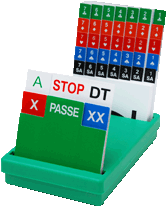Bridge history and evolution with emergence of new technologies.
There are different types of bridge games, all directly drawn from the Whist (card game popular in Europe during the nineteenth century, and ancestor of the bridge game which killed it).
1885: The "biritch" game
Also known under the name of "Russian Whist", appears in England.
1904: The auction bridge
Expands and replaces the whist bridge arround 1910.
1925: The contract bridge.
Harold Stirling Vanderbilt writes the rules of the contract bridge. Until the Second World War, the “bridge-plafond” is the most played bridge game, but it is the contract bridge that ousted all other forms of bridge and is now in use everywhere.
1983: bridge game on LAN
While studying in Canada, avid of bridge game, Thierry d'Herbigny invented a game software on a good old times PC weighting some eighty pounds, with no hard drive but only 5 inches floppy disks! He deploys his software on the local area network of Polytechnic School of Montreal.
1987: bridge game goes online.
Always on the lookout for new technologies, the software is constantly improving. In the 80s, the web is not yet born. But in France, telematics network grows, reaching millions of users with the wide dissemination of Minitel terminals. Thierry naturally puts his online gaming software to share it with other enthusiasts.
2007: bridge game goes mobile.
Thierry were the first to create a bridge game accessible through smartphone, premiered at a press conference during the International Bridge Festival of Biarritz.
2011: the bridge and its Playmate
Thierry presents his "Playmate" to staff and journalists at the International Bridge Festival in Deauville, very impressed with this novelty. This Playmate is the modern version of the Bridgemate but is also suitable for other games (Poker, Tarot, Belote ...) with today's technology: smartphone instead of a dedicated box and Wi-Fi network instead analog radio waves.
2013: bridge game at the era of "big data"
You play with robots that use not only their artificial intelligence but also hundreds of millions of human decisions made previously by real players. In brain games matters robots have their limits and none is able to replace the finesse of a human decision. For this reason we have adopted the opposite concept: it is the robots that are assisted by humans.
When the software has to make a decision, it searches the database for a human decision that resembles as closely as possible the situation in which it is. Indeed, in thirty years, we have accumulated hundreds of millions of boards in our database. Hence, a faithful player might see an opponent play a card he has played himself many years before. Playing this way is the best one to seriously evaluate your performance as none of your robotic opponents may share information without your knowledge.
 Thierry d'Herbigny |  NST |


